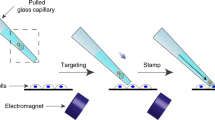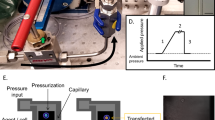Abstract
Biolistic transfection is a technique in which subcellular-sized particles coated with DNA are accelerated to high velocity to propel them into cells. This method is applicable to tissues, cells and organelles, and can be used for both in vitro and in vivo transformations; with the right equipment, it is simple, rapid and efficient. Here we provide a detailed protocol for biolistic transfection of plasmids into cultured human embryonic kidney (HEK) 293 cells and organotypic brain slices using a hand-held gene gun. There are three major steps: (i) coating microcarriers with DNA, (ii) transferring the microcarriers into a cartridge to make a 'bullet', and (iii) firing the DNA-coated microcarriers into cells using a pulse of helium gas. The method can be readily adapted to other cell types and tissues. The protocol can be completed in 1–2 h.
This is a preview of subscription content, access via your institution
Access options
Subscribe to this journal
Receive 12 print issues and online access
$259.00 per year
only $21.58 per issue
Buy this article
- Purchase on Springer Link
- Instant access to full article PDF
Prices may be subject to local taxes which are calculated during checkout





Similar content being viewed by others
References
Klein, T.M., Wolf, E.D., Wu, R. & Sanford, J.C. High-velocity microprojectiles for delivering nucleic acids into living cells. Nature 327, 70–73 (1987).
Christou, P., McCabe, D.E. & Swain, W.F. Stable transformation of soybean callus by DNA-coated gold particles. Plant Physiol. 87, 671–674 (1988).
Lin, M. The gene gun: current applications in cutaneous gene therapy. Int. J. Dermatol. 39, 161–170 (2000).
Yang, C.H. et al. Seeing the gene therapy: application of gene gun technique to transfect and decolour pigmented rat skin with human agouti signalling protein cDNA. Gene Ther. 11, 1033–1039 (2004).
O'Brien, J.A. et al. Modification to the hand-held gene gun: improvements for in vitro biolistic transfection of organotypic neuronal tissue. J. Neurosci. Methods 112, 57–64 (2001).
Jiao, S., Cheng, L., Wolff, J.A. & Yang, N.-S. Particle bombardment mediated gene transfer and expression in rat brain tissues. Biotechnology 11, 497–502 (1993).
Wirth, M.J. & Wahle, P. Biolistic transfection of organotypic cultures of rat visual cortex using a handheld device. J. Neurosci. Methods 125, 45–54 (2003).
Gerber, H.-P., Dixit, V. & Ferrara, N. Vascular endothelial growth factor induces expression of the antiapoptotic proteins Bcl2 and A1 in vascular endothelial cells. J. Biol. Chem. 273, 13313–13306 (1998).
Wellmann, H., Kaltschmidt, B. & Kaltschmidt, C. Optimized protocol for biolistic transfection of brain slices and dissociated cultured neurons with a hand-held gene gun. J. Neurosci. Methods 92, 55–64 (1999).
Sanford, J.C., Smith, F.D. & Russell, J.A. Optimizing the biolistic process for different biological applications. Methods Enzymol. 217, 483–509 (1993).
Hargreaves, A.C., Lummis, S.C. & Taylor, C.W. Ca2+ permeability of cloned and native 5-hydroxytryptamine type-3 receptors. Mol. Pharmacol. 46, 1120–1126 (1994).
Stoppini, L., Buchs, P.A. & Muller, D. A simple method for organotypic cultures of nervous tissue. J. Neurosci. Methods 37, 173–182 (1991).
Shaw, G., Morse, S., Ararat, M. & Graham, F.L. Preferential transformations of human neuronal cells by human adenoviruses and the origin of HEK-293 cells. FASEB J. 16, 869–871 (2002).
Wirth, M.J., Patz, S. & Wahle, P. Transcellular induction of neuropeptide Y expression by NT4 and BDNF. Proc. Natl. Acad. Sci. USA 102, 3064–3069 (2005).
Acknowledgements
This work was supported by the Medical Research Council and the Wellcome Trust. S.C.R.L. holds a Wellcome Trust Senior Research Fellowship in Basic Biomedical Science.
Author information
Authors and Affiliations
Corresponding author
Ethics declarations
Competing interests
The authors declare no competing financial interests.
Rights and permissions
About this article
Cite this article
O'Brien, J., Lummis, S. Biolistic transfection of neuronal cultures using a hand-held gene gun. Nat Protoc 1, 977–981 (2006). https://doi.org/10.1038/nprot.2006.145
Published:
Issue Date:
DOI: https://doi.org/10.1038/nprot.2006.145
This article is cited by
-
Particle bombardment-assisted peptide-mediated gene transfer for highly efficient transient assay
BMC Research Notes (2023)
-
Biointerface design for vertical nanoprobes
Nature Reviews Materials (2022)
-
Light triggered nanoscale biolistics for efficient intracellular delivery of functional macromolecules in mammalian cells
Nature Communications (2022)
-
Silver nanoparticles for biolistic transformation in Nicotiana tabacum L.
3 Biotech (2021)
-
Rac1 is a downstream effector of PKCα in structural synaptic plasticity
Scientific Reports (2020)
Comments
By submitting a comment you agree to abide by our Terms and Community Guidelines. If you find something abusive or that does not comply with our terms or guidelines please flag it as inappropriate.



